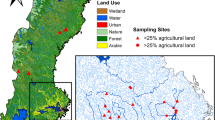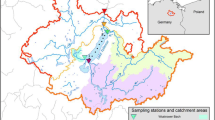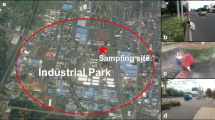Abstract
Transport of hydrophobic organic pollutants in rivers is mainly coupled to transport of suspended particles. Turbidity measurements are often used to assess the amount of suspended solids in water. In this study, a monitoring campaign is presented where the total concentration of polycyclic aromatic hydrocarbons (PAHs), the amount of total suspended solids (TSS), and turbidity was measured in water samples from five neighboring catchments in southwest Germany. Linear correlations of turbidity and TSS were obtained which were in close agreement to the literature data. From linear regressions of turbidity versus total PAH concentrations in water, mean concentrations of PAH on suspended particles could be calculated and these varied by catchment. These values furthermore comprise a robust measure of the average sediment quality in a given catchment. Since in the catchments investigated in this study, PAH concentrations on suspended particles were stable over a large turbidity range (1–114 Nephelometric Turbidity Units), turbidity could be used as a proxy for total PAHs and likely other highly hydrophobic organic pollutants in river water if the associated correlations are established. Based on that, online monitoring of turbidity (e.g., by optical backscattering sensors) seems very promising to determine annual pollutant fluxes.





Similar content being viewed by others
References
Boden AR, Reiner EJ (2004) Development of an isotope-dilution gas chromatographic mass spectrometric method for the analysis of polycyclic aromatic compounds in environmental matrices. Polycycl Aromat Comp 24:309–323
Bradley SB, Lewin J (1982) Transport of heavy metals on suspended sediments under high flow conditions in a mineralized region of Wales. Environ Pollut (Series B) 4:257–267
Chiou CT, Malcolm RL, Brinton TI, Kile DE (1986) Water solubility enhancement of some organic pollutants and pesticides by dissolved humic and fulvic acids. Env Sci Technol 20:502–508
DIN 38407-39 (2008) German standard methods for the examination of water, waste water and sludge; jointly determinable substances (group F)—determination of selected polycyclic aromatic hydrocarbons (PAH)—method using gas chromatography with mass spectrometric detection (GC-MS). August 2008
Dodds WK, Whiles MR (2004) Quality and quantity of suspended particles in rivers: continent-scale patterns in the United States. Environ Manag 33(3):355–367. doi:10.1007/s00267-003-0089-z
Downing J (2006) Twenty-five years with OBS sensors: the good, the bad, and the ugly. Cont Shelf Res 26:2299–2318
Fries JS, Noble RT, Paerl HW, Characklis GW (2007) Particle suspensions and their regions of effect in the Neuse river estuary: implications for water quality monitoring. Estuar Coasts 30:359–364
Gentile F, Bisantino T, Corbino R, Milillo F, Romano G, Trisorio Liuzzi G (2010) Monitoring and analysis of suspended sediment transport dynamics in the Carapelle torrent (southern Italy). Catena 80:1–8
Gippel CJ (1995) Potential of turbidity monitoring for measuring the transport of suspended solids in streams. Hydrol Process 9:83–97
Grathwohl P, Rügner H, Wöhling T, Osenbrück K, Schwientek M, Gayler S, Wollschläger U, Selle B, Pause M, Delfs J-O, Grzeschik M, Weller U, Ivanov M, Cirpka OA, Maier U, Kuch B, Nowak W, Wulfmeyer V, Warrach-Sagi K, Streck T, Attinger S, Bilke L, Dietrich P, Fleckenstein JH, Kalbacher T, Kolditz O, Rink K, Samaniego L, Vogel H-J, Werban U, Teutsch G (2013) Catchments as reactors—a comprehensive approach for water fluxes and solute turn-over. Environ Earth Sci 69(2) doi:10.1007/s12665-013-2281-7
Gray JR, Glysson GD (eds) (2002) In: Proceedings of the federal interagency workshop on turbidity and other sediment surrogates. US Geological Survey Circular 1250, Reno, Nevada, 30 April–2 May 2002. http://pubs.usgs.gov/circ/2003/circ1250/pdf/circ1250.book_web.pdf
Grayson RB, Finlayson BL, Gippel CJ, Hart BT (1996) The potential of field turbidity measurements for the computation of total phosphorus and suspended solids loads. J Environ Manag 47:257–267
Hornsburgh JS, Jones AS, Stevens DK, Tarboton DG, Mesner NO (2010) A sensor network for high frequency estimation of water quality constituent fluxes using surrogates. Environ Monit Softw 25:1031–1044
Huey GM, Meyer ML (2010) Turbidity as an indicator of water quality in diverse watersheds of the upper Pecos river basin. Water 2(2):273–284. doi:10.3390/w2020273
Kirchner JW, Austin CM, Myers A, Whyte DC (2011) Quantifying remediation effectiveness under variable external forcing using contaminant rating curves. Environ Sci Technol 45:7874–7881
Kleineidam S, Rügner H, Grathwohl P (1999) Slow sorption in heterogeneous aquifer material. Environ Toxicol Chem 18:1673–1678
Ko FC, Baker JE (2004) Seasonal and annual loads of hydrophobic organic contaminants from the Susquehanna river basin to the Chesapeake bay. Marine Pollut Bull 48:840–851
Lin GW, Chen H, Petley DN, Horng M-J, Wu S-J, Chuang B (2011) Impact of rainstorm-triggered landslides on high turbidity in a mountain reservoir. Eng Geol 117:97–103
Loperfido JV, Just CL, Papanicolaou AN, Schnoor JL (2010) In situ sensing to understand diel turbidity cycles, suspended solids, and nutrient transport in Clear Creek, Iowa. Water Res Res 46:W06525. doi:10.1029/2009WR008293
Parkhill KL, Gulliver JS (2002) Effect of inorganic sediment on whole-stream productivity. Hydrobiologia 472:5–17
Rossi L, Chèvre N, Fankhauser R, Margot J, Curdy R, Babut M, Barry DA (2013) Sediment contamination assessment in urban areas based on total suspended solids. Water Res 47:339–350
Rügner H, Kleineidam S, Grathwohl P (1999) Long term sorption kinetics of phenanthrene in aquifer materials. Environ Sci Technol 33:1645–1651
Schwarz K, Gocht T, Grathwohl P (2011) Transport of polycyclic aromatic hydrocarbons in highly vulnerable karst systems. Environ Pollut 159:133–139
Schwientek M, Rügner H, Beckingham B, Kuch B, Grathwohl P (2013a) Integrated monitoring of transport of persistent organic pollutants in contrasting catchments. Environ Pollut 172:155–162
Schwientek M, Osenbrück K, Fleischer M (2013b) Investigating hydrological drivers of nitrate export dynamics in two agricultural catchments in Germany using high-frequency data series. Environ Earth Sci 69(2). doi:10.1007/s12665-013-2322-2
Spackman Jones A, Stevens DK, Horsburgh JS, Mesner NO (2011) Surrogate measures for providing high frequency estimates of total suspended solids and total phosphorus concentrations. J Am Water Resour Assoc (JAWRA) 47(2):239–253
Standards Methods Organisation (1997) Standards Methods 2540D. http://www.standardmethods.org/AboutSM/
Stubblefield AP, Reuter JE, Dahlgren RA, Goldman CR (2007) Use of turbidimetry to characterize suspended sediment and phosphorus fluxes in the Lake Tahoe basin, California, USA. Hydrol Process 21:281–291
Sulaiman WNA, Hamid MR (1993) Suspended sediment and turbidity relationships for individual and multiple catchments. Universiti Putra, Malaysia, p 132
Thackston EL, Palermo MR (2000) Improved methods for correlating turbidity and suspended solids for monitoring. In: DOER technical notes collection (ERDC TN-DOER-E8). US Army Engineer Research and Development Center, Vicksburg. http://el.erdc.usace.army.mil/elpubs/pdf/doere8.pdf
Uhrich MA, Bragg HM (2000) Monitoring instream turbidity to estimate continuous suspended-sediment loads and yields and clay-water volumes in the upper north Santiam river basin, Oregon, 1998–2000. USGS water-resources investigations report 03-4098, USA. http://pubs.usgs.gov/wri/WRI03-4098/
Weiß H (1998) Säulenversuche zur Gefahrenbeurteilung für das Grundwasser an PAK-kontaminierten Standorten. Tübinger Geowissenschaftliche Arbeiten (TGA) Reihe C 45, p 111
Ziegler AD, Xi LX, Tantasarin C (2011) Sediment load monitoring in the Mae Sa catchment in northern Thailand. In: Walling DE (ed) Sediment problems and sediment management in Asian river basins, 349th edn. IAHS, Wallingford, pp 86–91
Acknowledgments
This work was supported by a grant from the Ministry of Science, Research and Arts of Baden-Württemberg (AZ Zu 33-721.3-2) and the Helmholtz Centre for Environmental Research, UFZ, Leipzig.
Author information
Authors and Affiliations
Corresponding author
Rights and permissions
About this article
Cite this article
Rügner, H., Schwientek, M., Beckingham, B. et al. Turbidity as a proxy for total suspended solids (TSS) and particle facilitated pollutant transport in catchments. Environ Earth Sci 69, 373–380 (2013). https://doi.org/10.1007/s12665-013-2307-1
Received:
Accepted:
Published:
Issue Date:
DOI: https://doi.org/10.1007/s12665-013-2307-1




